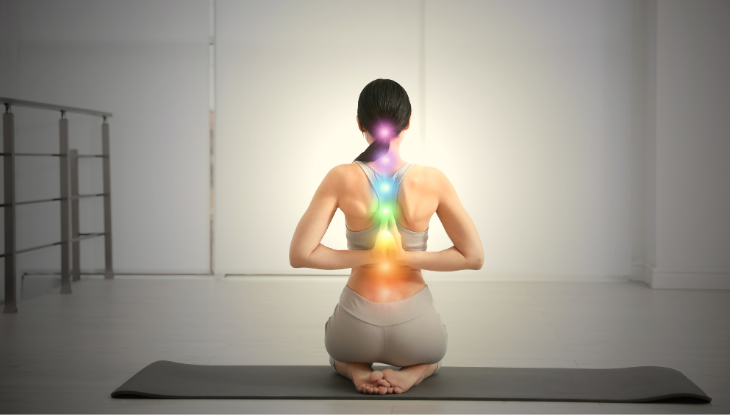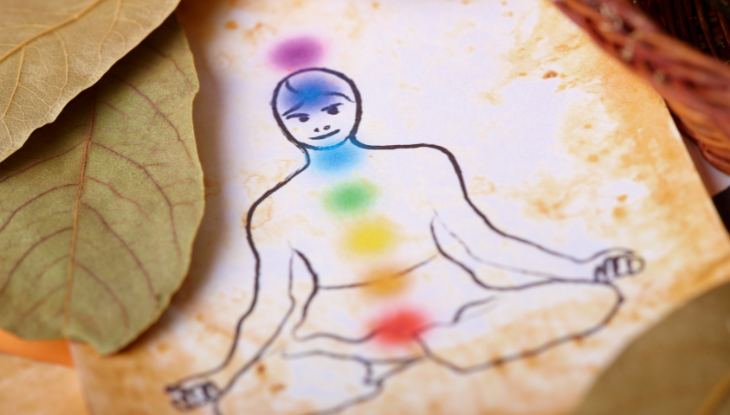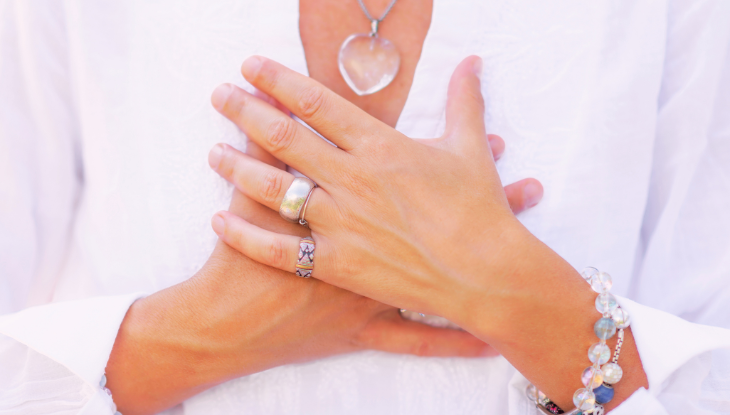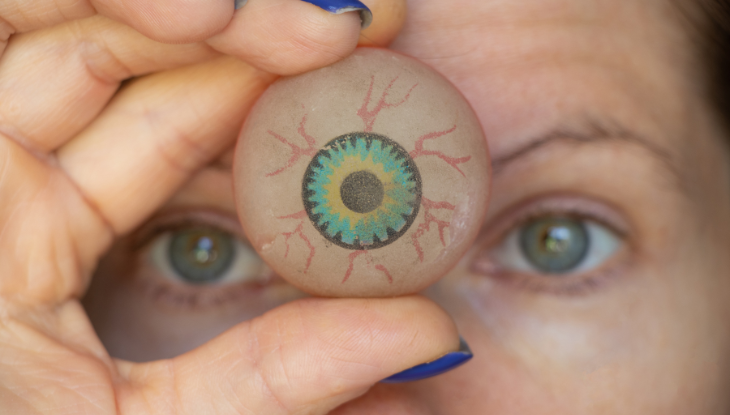Interest in chakras and their impact on our lives is growing. People around the world are seeking ways to harmonise life energy and improve their well-being. Chakras play a key role here, acting as energetic centres in our body.
In this article, we will explore how you can harmonise your life energy through chakras. You will learn about the functions of each chakra, as well as their significance for our health and well-being, and the techniques you can use to improve their functioning.
What are chakras?
Chakras are the foundation of our energetic existence. They work like energy whirls flowing through our body. Each of the seven main chakras has its unique location and functions. These energy centres connect with various aspects of our life, from physical to spiritual.
The first chakra, the root chakra, is located at the base of the spine. It provides a sense of security and stability. At the opposite end of the spectrum lies the crown chakra. Situated at the top of the head, it opens us up to higher consciousness and spirituality. Each chakra between them, from the sacral to the third eye, is responsible for various organs and emotions.
Balance between chakras is crucial for our health and well-being. The harmonious functioning of these centres translates into mental and physical health. Moreover, chakras influence our ability to cope with stress and emotional challenges. Understanding the role and function of each chakra is the first step towards achieving inner harmony.
What are chakras and what do they represent?
Chakras are key energy centres in our body that deeply influence various aspects of our lives. Both physical and spiritual. Each of them is responsible for specific areas of our existence. From basic survival needs, through the ability to love, to the pursuit of spiritual harmony. In this section, we will take a closer look at what each chakra is and what they are exactly responsible for, in order to better understand their role in our daily lives.

1. Root Chakra (Muladhara)
The Muladhara, also known as the root chakra, forms the foundation of our existence. Located at the base of the spine, it provides a sense of being rooted in reality. This chakra influences our sense of security and stability. When open and functioning correctly, we feel confident. Ready to face challenges and maintain stability in difficult situations. A blockage in this chakra can cause anxiety and a sense of threat, as if we were standing on unstable ground.
The root chakra is connected to fundamental issues of survival, such as financial independence, money, and access to food. What speaks to me most in the context of Muladhara is its mantra: “I cannot grow on an uncertain foundation.” This perfectly captures the idea that without a solid base, it is difficult to achieve stability in other areas of life.
The colour red symbolises this chakra, which is no coincidence, as red is the colour of energy, strength, and life passion. The earth element further emphasises its connection to stability and security. Hematite is a recommended stone for Muladhara, known for its grounding properties. Yoga offers many poses supporting this chakra, but Warrior I pose seems to be particularly effective in harmonising it. This chakra mainly develops in the first seven years of life, which is crucial for building the foundation of our sense of security in adulthood.
2. Sacral Chakra (Swadhisthana)
Swadhisthana, also known as the sacral chakra, plays a key role in our emotional life. It is the centre that helps us understand our own emotions and the emotions of others. It also has a huge impact on creativity and sexual energy.
This chakra is located in the lower part of the abdomen, roughly two fingers below the navel. It influences feelings of abundance, well-being, pleasure, and sexuality. What particularly strikes me about its characteristics is the mantra: “I always respect others, but never at the expense of myself.” It is a reminder of how important it is to not forget about ourselves and our own boundaries in relationships with other people.
The orange colour representing this chakra symbolises energy and the joy of life. The element associated with Swadhisthana is water, highlighting its fluidity and ability to adapt. The yoga pose linked to the sacral chakra is Bound Angle Pose, which supports its opening and balance. This chakra develops between the ages of 8 and 14, which is crucial for forming healthy relationships with one’s own emotions and sexuality later in life.

3. Solar Plexus Chakra (Manipura)
Manipura, or the solar plexus chakra, is the third energy centre that is responsible for our self-confidence and ability to control our own lives. You can feel it in action when experiencing butterflies in the stomach or a feeling of heaviness in the stomach area – that’s the manifestation of Manipura at work.
When the solar plexus chakra is blocked, we may be overwhelmed by strong feelings of shame and self-doubt. In contrast, people with an open Manipura enjoy the freedom to express their true nature without fear.
It is located in the upper part of the abdomen, right by the stomach and is crucial for our sense of self-worth, confidence, and self-esteem. Its mantra, “Self-love begins when I accept all parts of myself,” reminds us of the importance of self-acceptance in building healthy self-confidence. The colour yellow symbolises this chakra, representing energy and vitality, while the element is fire, emphasising its strength and dynamism.
4. Heart Chakra (Anahata)
Anahata, known as the heart chakra, combines the material elements of lower chakras with the spirituality of those higher up. The key role of this chakra is to influence our ability to love – both others and ourselves. This centre of love allows for a true opening up to relationships with others and experiencing deep compassion and empathy.
This chakra is located in the centre of the chest, slightly above the heart, and is responsible for love, joy, and inner peace. Its mantra, “When I love myself, it is easy for me to love others”, emphasises the importance of self-acceptance for the ability to build healthy relationships. The green colour of this chakra symbolises growth and renewal, and its element is air, which relates to lightness and freedom.
The yoga pose that supports Anahata is Camel Pose, helping to open the heart and improve energy flow. The heart chakra develops between the ages of 21 and 28, which is an important time for shaping our ability to form deep emotional bonds.

5. Throat Chakra (Vishuddha)
Vishuddha, known as the throat chakra, enables the heart to express itself through words and controls our ability to communicate our own power. When functioning correctly, it allows us to express ourselves authentically and clearly. Individuals with a blocked throat chakra may struggle to express their true feelings and thoughts.
It is located in the throat area and is responsible for communication, self-expression, and truth. The mantra of this chakra, “I always speak my truth,” is a reminder of the power of words and the importance of authenticity. The light blue or turquoise colour symbolises Vishuddha, reflecting the peace and clarity of communication. The element of this chakra is sound or music, emphasising its connection to expression and words.
Aquamarine, a stone associated with this chakra, is valued for its properties supporting communication and soothing the stress associated with expression. The Fish Pose in yoga is recommended for enhancing openness in Vishuddha, facilitating deeper and more authentic communication. The development of this chakra occurs between the ages of 29 and 35, which is a crucial period for honing the skills of self-expression and communication with others.
6. Third Eye Chakra (Ajna)
The third eye chakra, also known as Ajna, is located on the forehead, precisely between the eyebrows. It is a metaphorical window through which our soul observes the world, not limiting itself to just the material aspects of reality. It is responsible for important aspects of the human psyche such as intuition, imagination, and wisdom. It allows us to perceive the deeper meaning of our surroundings and events. Its colours, dark blue and violet, along with its associated stone – amethyst, symbolise spirituality and depth of perception. For people with an open Ajna, visions and intuitions are part of their daily experience, opening up extraordinary perspectives and possibilities for them.
This chakra, developing between the ages of 36 and 42, symbolises spiritual maturity and the ability to understand oneself and the world on a deeper level. During this time, many people experience significant expansion of their mental and spiritual horizons. Ajna is associated with the element of light, emphasising its role in enlightening the mind and spirit. The mantra “I am open to exploring the unseen” perfectly captures the essence of this chakra, encouraging openness to unknown and invisible aspects of reality. The practice of yoga, especially Child’s Pose, helps to focus attention on the third eye, supporting the development of intuition and inner wisdom.

7. Crown Chakra (Sahasrara)
Sahasrara, also known as the crown chakra, resides at the top of the head and is considered the highest point in the chakra system. It symbolises a comprehensive spiritual connection with the universe, and its opening – a task achievable by only a few – enables the attainment of higher consciousness and deeper understanding. Positioned at the crown of the head, Sahasrara plays a pivotal role in our spirituality and how we perceive inner and outer beauty, teaching us that we are vessels of love and light.
The dominant colours of this chakra, purple and white, represent purity and spiritual wisdom, emphasizing its deep connections to divine consciousness and suggesting that its influence extends far beyond the material world. Clear quartz, a stone associated with Sahasrara, due to its properties such as amplifying energy and thoughts, is an ideal tool supporting the pursuit of spiritual harmony. Furthermore, the practice of headstand in yoga, supporting the work of this chakra, not only physically but also symbolically reflects our aspirations to achieve higher states of consciousness.
The Sahasrara development that occurs between the ages of 43 and 49 often involves reaching spiritual maturity and gaining a deeper understanding of one’s place in the cosmos. It emphasises that our spiritual journey is a continuous process, offering infinite opportunities for growth and deeper connection.
Can chakras influence health?
Chakras, located in specific regions of our body, are closely connected to the organs and glands of that area. They have a significant impact not only on our physical health but also on our mental state and relationships with others. The balance in chakras depends on many factors such as lifestyle, environment, life experiences, and many others. They can be balanced or unbalanced, depending on these aspects.
When a chakra is unbalanced, it can work too weakly or too intensely. A weakly active, or blocked chakra, means that its operation is limited or insufficient. On the other hand, excessive chakra activity indicates that too much energy is flowing to a particular part of the body. This leads to an imbalance in the flow of energy throughout the body.
How to unblock chakras?
There is no one universal method to unblock chakras; there are many ways, and the best method varies depending on the individual. Here are a few popular tools and techniques for clearing and balancing chakras.
Taking care of chakras and balancing them can be done in various ways, combining both the physical and spiritual aspects of our lives. Starting with diet, which affects the balance of the five elements in our body, through asanas – yoga poses that stimulate chakras and support their proper functioning and self-healing, to breathing techniques that increase the flow of life-giving prana and help eliminate stagnant energy.
Extremely important is also chakra meditation, which calms the mind and allows you to focus on areas that require attention, as well as mudras, specific hand gestures used in yoga and meditation practices. These gestures direct energy to the places that need it most, helping to restore harmony in the chakra system. All of these methods combine into a holistic approach to health and well-being, highlighting the importance of balance between body and spirit.
In summary
Seven chakras are key points in the human body’s energy field, playing a fundamental role in maintaining a healthy physical and emotional balance. That’s why it’s so important to regularly pay attention to these energy centres. Also, to find time in our busy lives to improve the flow of prana to each of them. Harmonising the chakras not only leads to better daily well-being but also opens the door to a deeper understanding of oneself and the release of inner, divine power. From my perspective, working with chakras is not only a way to improve health but also a path of spiritual development that allows us to discover and utilise our full potential.
